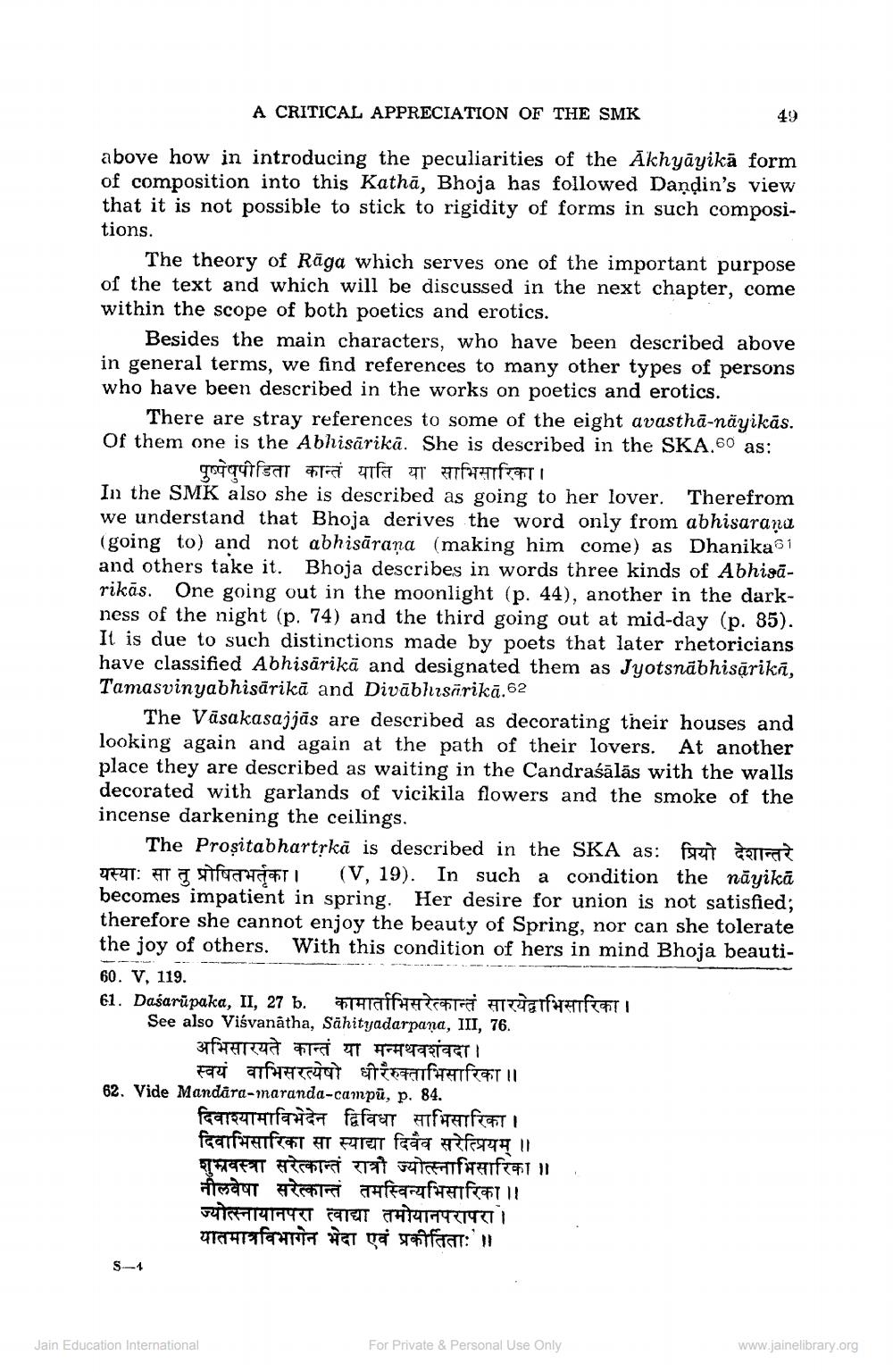________________
A CRITICAL APPRECIATION OF THE SMK
above how in introducing the peculiarities of the Akhyāyikā form of composition into this Katha, Bhoja has followed Dandin's view that it is not possible to stick to rigidity of forms in such composi
tions.
The theory of Raga which serves one of the important purpose of the text and which will be discussed in the next chapter, come within the scope of both poetics and erotics.
Besides the main characters, who have been described above in general terms, we find references to many other types of persons who have been described in the works on poetics and erotics.
There are stray references to some of the eight avasthā-näyikās. Of them one is the Abhisarikā. She is described in the SKA.60 as: goguise कान्तं याति या साभिसारिका ।
In the SMK also she is described as going to her lover. Therefrom we understand that Bhoja derives the word only from abhisarana (going to) and not abhisarana (making him come) as Dhanika 1 and others take it. Bhoja describes in words three kinds of Abhisārikās. One going out in the moonlight (p. 44), another in the darkness of the night (p. 74) and the third going out at mid-day (p. 85). It is due to such distinctions made by poets that later rhetoricians have classified Abhisarika and designated them as Jyotsnābhisārikā, Tamasvinyabhisarika and Divabhisarikā.62
49
The Vasakasajjās are described as decorating their houses and looking again and again at the path of their lovers. At another place they are described as waiting in the Candraśālās with the walls decorated with garlands of vicikila flowers and the smoke of the incense darkening the ceilings.
The Prositabhartṛka is described in the SKA as: fat
यस्याः सा तु प्रोषितभर्तृका । (V, 19). In such a condition the nayikā becomes impatient in spring. Her desire for union is not satisfied; therefore she cannot enjoy the beauty of Spring, nor can she tolerate the joy of others. With this condition of hers in mind Bhoja beauti
60. V, 119.
61. Dasarupaka, II, 27 b. कामार्ताभिसरेत्कान्तं सारयेद्वाभिसारिका ।
See also Viśvanatha, Sahityadarpana, III, 76. अभिसारयते कान्तं या मन्मथवशंवदा । स्वयं वाभिसरत्येषो धीरैरुक्ताभिसारिका ॥
62. Vide Mandara-maranda-campu, p. 84. दिवाश्यामाविभेदेन द्विविधा साभिसारिका । दिवाभिसारिका सा स्याद्या दिवैव सरेत्प्रियम् ॥ शुभ्रवस्त्रा सरेत्कान्तं रात्रौ ज्योत्स्नाभिसारिका ॥ नीलवेषा सरेत्कान्तं तमस्विन्यभिसारिका ॥ ज्योत्स्नायानपरा त्वाद्या तमोयानपरापरा । यातमात्रविभागेन भेदा एवं प्रकीर्तिताः ॥
S-4
Jain Education International
For Private & Personal Use Only
www.jainelibrary.org




